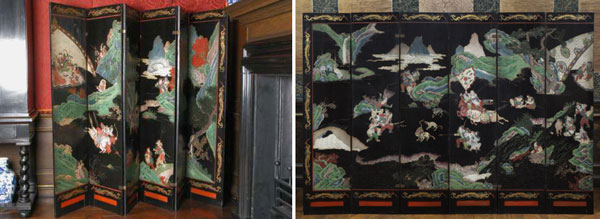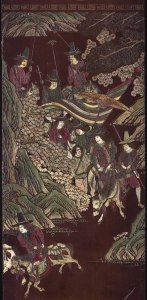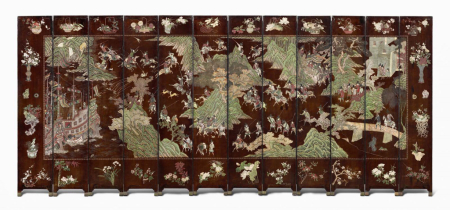Emlie de Bruijn, Registrar at the National Trust, is a heritage professional who uncovers many of the hidden gems found throughout the vast Trust collection. He documents and posts his latest findings through his blog National Trust Treasure Hunt. Emile has agreed to let Royal Oak share his posts here, on AngloFiles for you, our members. Sign up for Emile’s emails on his blog to stay connected with the latest findings in the National Trust’s collection.
Enjoy below Emile’s recap of the study day he attended with the Peabody Essex Museum.
By Emile de Bruijn

L: The other half of the twelve-fold incised lacquer screen (NT 1139776), in a different room at Ham. ©National Trust/Christopher Warleigh-Lack. R: Six-fold incised lacquer screen decorated with scenes of Europeans hunting, seventeenth century (NT 1140102), one half of what was originally a twelve-fold screen, at Ham House. ©National Trust Images/John Hammond.
I have just returned from speaking at a stimulating study day at the Peabody Essex Museum in Salem, Massachusetts. As I mentioned earlier, I was talking about ‘Sino-Dutch’ interiors in late seventeenth-century England.
While I was there I also visited the Museum of Fine Arts (MFA) in Boston. I discovered that among the rich holdings of the MFA is a Chinese incised lacquer screen depicting Europeans out hunting. This reminded me of a screen with a similar subject at Ham House (separated in two parts, documented here and here), which had previously puzzled me.
This kind of depiction of westerners, with big noses, prominent moustaches and wide, pantaloon-style trousers, is known from Japanese screens, where the subject was called ‘namban’ or ‘southern barbarians’ – since the western ships arrived in japan from the south.
The Japanese were clearly fascinated by these exotic foreigners. But here this subject and style of depiction has been transposed to incised or kuan cai lacquer, which as far as we know was only made in China.

Detail from the Chinese incised lacquer screen depicting Europeans in a landscape. Museum of Fine Arts, Boston, 1975.333, Keith McLeod Fund. © 2016 Museum of Fine Arts, Boston
So what was going on here? In their Arts of China handbook the MFA curators suggest that this type of screen was made in China, to be exported to Japan and to be sold there to the Dutch merchants based in Nagasaki.
That certainly sounds plausible, but I wonder whether there could also have been a market in China itself for screens decorated with quaint barbarians – a kind of chinoiserie in reverse? Either way, it is great to discover that the Ham screen is not an odd one-off but seems to have been part of a particular genre.




